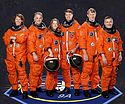STS-112
 | |
| Dane misji | |
| Indeks COSPAR | 2002-047A |
|---|---|
| Zaangażowani | |
| Oznaczenie kodowe | STS-112 |
| Pojazd | |
| Wahadłowiec | Atlantis |
| Załoga | |
 Od lewej: Sandra H. Magnus, David A. Wolf, Pamela A. Melroy, Jeffrey S. Ashby, Piers J. Sellers, Fiodor Jurczichin | |
| Dowódca | Jeffrey S. Ashby |
| Start | |
| Miejsce startu | Stany Zjednoczone, KSC, LC39-B |
| Początek misji | 7 października 2002 19:45:51 UTC[1] |
| Orbita okołoziemska | |
| Apogeum | 405 km |
| Perygeum | 273 km |
| Okres orbitalny | 91,3 min |
| Inklinacja orbity | 51,6° |
| Lądowanie | |
| Miejsce lądowania | KSC, pas startowy 33 |
| Lądowanie | 18 października 2002 15:43:40 UTC[1] |
| Czas trwania misji | 10 dni, 19 godzin, 57 minut i 49 sekund[1][2] |
| Przebyta odległość | 7,24 mln km[2] |
| Liczba okrążeń Ziemi | 170[2] |
| Program lotów wahadłowców | |
STS-112 (ang. Space Transportation System) – 10-dniowa misja wahadłowca Atlantis do Międzynarodowej Stacji Kosmicznej w październiku 2002 roku[2]. Był to dwudziesty szósty lot promu kosmicznego Atlantis i sto jedenasty programu lotów wahadłowców[2][3].
Załoga
- źródło[3]
- Jeffrey S. Ashby (3)*, dowódca (CDR)
- Pamela A. Melroy (2), pilot (PLT)
- David A. Wolf (3), specjalista misji (MS1)
- Piers J. Sellers (1), specjalista misji (MS3)
- Sandra H. Magnus (1), specjalista misji (MS2)
- Fiodor Jurczichin (1), specjalista misji (MS4) (RSC, Rosja)
- *(liczba w nawiasie oznacza liczbę lotów odbytych przez każdego z astronautów)
Parametry misji
- Masa:
- startowa orbitera: 116 538 kg
- lądującego orbitera: 91 390 kg
- ładunku: 12 572 kg
- Perygeum: 273 km[4]
- Apogeum: 405 km[4]
- Inklinacja: 51,6°[4]
- Okres orbitalny: 91,3 min[4]
Cel misji
Piętnasty lot wahadłowca na stację kosmiczną ISS – dostarczenie segmentu S1 kratownicy ITS[3].
Dokowanie do ISS
- Połączenie z ISS: 9 października 2002, 15:16:15 UTC[1]
- Odłączenie od ISS: 16 października 2002, 13:13:30 UTC[1]
- Łączny czas dokowania: 6 dni, 21 h, 57 min, 15 s
Zobacz też
Przypisy
- ↑ a b c d e Spaceflight mission report: STS-112 (ang.). Spacefacts. [dostęp 2017-07-27].
- ↑ a b c d e KSC: Podsumowanie misji STS-112 (ang.). [dostęp 2014-06-22].
- ↑ a b c Tomáš Přibyl: Dzień, w którym nie wróciła COLUMBIA. Bielsko-Biała: Wydawnictwo >DEBIT<, 2003, s. 177. ISBN 83-7167-224-1.
- ↑ a b c d Mark Wade: STS-112 (ang.). W: Encyclopedia Astronautica [on-line]. [dostęp 2017-07-27].
Linki zewnętrzne
- KSC: Podsumowanie misji STS-112 (ang.). [dostęp 2014-06-22].
- Mark Wade: STS-112 (ang.). W: Encyclopedia Astronautica [on-line]. [dostęp 2017-07-27].
- Spaceflight mission report: STS-112 (ang.). Spacefacts. [dostęp 2017-07-27].
Media użyte na tej stronie
The flag of Navassa Island is simply the United States flag. It does not have a "local" flag or "unofficial" flag; it is an uninhabited island. The version with a profile view was based on Flags of the World and as a fictional design has no status warranting a place on any Wiki. It was made up by a random person with no connection to the island, it has never flown on the island, and it has never received any sort of recognition or validation by any authority. The person quoted on that page has no authority to bestow a flag, "unofficial" or otherwise, on the island.
These five astronauts and cosmonaut take a break from training to pose for the STS-112 crew portrait. Astronauts Jeffrey S. Ashby and Pamela A. Melroy, commander and pilot, respectively, are in the center of the photo. The mission specialists are, from left to right, astronauts Sandra H. Magnus, David A. Wolf and Piers J. Sellers and cosmonaut Fyodor Yurchikhin, who represents Rosaviakosmos.
The STS-112 emblem symbolizes the ninth assembly mission (9A) to the International Space Station (ISS), a flight which is designed to deliver the Starboard 1 (S1) truss segment. The 30,000 pound truss segment will be lifted to orbit in the payload bay of the Space Shuttle Atlantis and installed using the ISS robotic arm. Three space walks will then be carried out to complete connections between the truss and ISS. Future missions will extend the truss structure to a span of over 350 feet so that it can support the solar arrays and radiators which provide the electrical power and cooling for ISS. The STS-112 emblem depicts ISS from the viewpoint of a departing shuttle, with the installed S1 truss segment outlined in red. A gold trail represents a portion of the Shuttle rendezvous trajectory. Where the trajectory meets ISS, a nine-pointed star represents the combined on-orbit team of six shuttle and three ISS crew members who together will complete the S1 truss installation. The trajectory continues beyond the ISS, ending in a six-pointed star representing the Atlantis and the STS-112 crew.




